#biodiversity celebration
Explore tagged Tumblr posts
Text
How does one invite a Psychedelic Rock Gecko to a 70s disco party?
Imagine the scene: a vibrant 70s disco party with spinning disco balls, colorful lights, and funky beats. Now, add a whimsical twist by inviting a Psychedelic Rock Gecko to join the festivities. While the concept is purely fanciful, it provides a creative framework to explore the unique characteristics of geckos, the essence of the 70s disco era, and the imaginative fusion of the two worlds.…
#70s disco party#animal behavior#animal imagination#animal-themed events#artistic expression#biodiversity celebration#conservation awareness#creative concepts#cultural fusion#cultural nostalgia#dance floor#disco era#disco lights#environmental enrichment#fantasy invitation#fantasy party#glittering gecko#groovy beats#imaginative exploration#imaginative fusion#imaginative storytelling#music and dance#natural world#neon colors#nostalgic celebration#party planning#psychedelic patterns#psychedelic rock gecko#vibrant colors#whimsical scenarios
0 notes
Text
Greenery Day: Celebrating Nature and Discovery

View On WordPress
#2024 Results Unveiling#Akihito#Aquatic Life Exploration#Biodiversity Cataloging#Biological Legacy#Botanical Insight#British Royal Society#Carl Linnaeus#citizen scientists#City Nature Challenge#Conservation Advocacy#Cultural Tradition#Discovery Spirit#Emperor Showa#environmental conservation#Environmental Discovery#environmental stewardship#Friends of the Saskatoon Afforestation Area#George Genereux Urban REgional Park#Global Nature Initiative#Gobiidae Fish#Greenery Day#Greenery Day Celebration#Hirohito#Historical Scientific Journey#Howard Sanders#Hydrozoans#Imperial Scientific Legacy#invasive species tracking#Linnean Society
2 notes
·
View notes
Text
#polls#university#studying#fanfiction#ao3#cars#photography#elephants#firearms#celebrity crush#trees#biodiversity
1 note
·
View note
Text
Unique things about India
India is a diverse and culturally rich country with a multitude of unique aspects that make it stand out from the rest of the world. Here are five of the best unique things about India: Incredible cuisine: Indian cuisine is known for its unique blend of spices and flavors that create an explosion of taste in the mouth. From rich curries to mouth-watering street food, Indian cuisine has something…
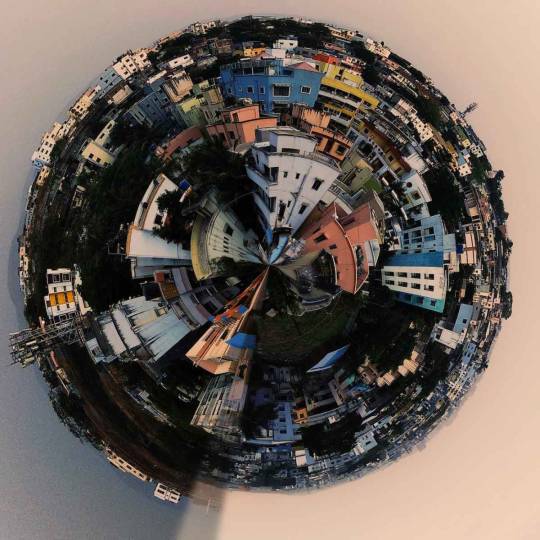
View On WordPress
#5 Unique things in india#Biodiversity#celebration#Featival#Incredible cuisine#Travel#Travel articles#unique things in India
0 notes
Text
youtube
These Salamanders Steal Genes and Can Have up to Five Extra Sets of Chromosomes
Unisexual salamanders in the genus Ambystoma appear to be the only creatures in the world that reproduce the way they do. Researchers know how, but the why is still being figured out.
Katy Greenwald: These are all pond breeding salamanders. They are really abundant in the Great Lakes. They are gene thieves. They're stealing DNA from other species. It is known as kleptogenesis. They are usually just called the unisexual complex or the unisexual Ambystoma. They are not a species, actually, because they break all the rules of what a species should be able to do. They are a really unique lineage. As far as we know there is nothing else in the world that reproduces in this way. They are five or six million year old group of animals. As a biologist, you learn all these rules and intro bio and then you learn about these things that just break the rules. In the water, the males will produce sperm at offers, which are little sperm packets that they sort of put down on on leaves and sticks and things like that in the pond. And the females will pick those up internally in their cloaca and there's internal fertilization, and then they'll lay fertilized eggs, which will develop into larvae just like tadpoles do in frogs. And these unisex rules will be in the same ponds at the same time as these normal sexually reproducing species. And they will actually pick up the sperm at offers that are produced by the males of the other species that just triggers egg development. So their eggs are laid and they develop, but they don't actually include any of the males genetic material and they produce offspring that just have the same DNA as the mom. But a smaller proportion of the time they actually do add the males genomes, and so then the offspring come out with extra chromosomes. So they can have anywhere from two to five full sets of chromosomes from up to five different species. And these salamanders seem to have the benefits of asexuality in that they're all female. Their populations can grow really fast, but they have this mechanism to add additional genetic variation that they're able to grab from these species that they coexist with. If there's one thing that we learn from studying biodiversity, it's that there is amazing variation in nature. There are all kinds of species reproducing in all kinds of ways, using all kinds of different approaches. And I think that's something we could certainly learn from in human society, that valuing and celebrating that diversity is a great part of being a biologist...
via: https://www.scientificamerican.com/video/these-salamanders-steal-genes-and-can-have-up-to-five-extra-sets-of-chromosomes
957 notes
·
View notes
Text
"Nouabalé-Ndoki National Park in Brazzaville, Republic of Congo has a lot to celebrate.
The park, which celebrated its 30th anniversary on December 31 of 2023, also shared an exciting conservation milestone: 2023 was the first year without any elephant poaching detected.
“We didn’t detect any elephants killed in the Park this year, a first for the Park since [we] began collecting data. This success comes after nearly a decade of concerted efforts to protect forest elephants from armed poaching in the Park,” Ben Evans, the Park’s management unit director, said in a press release.
Nouabalé-Ndoki National Park was developed by the government of Congo in 1993 to maintain biodiversity conservation in the region, and since 2014, has been cared for through a public-private partnership between Congo’s Ministry of Forest Economy and the Wildlife Conservation Society.
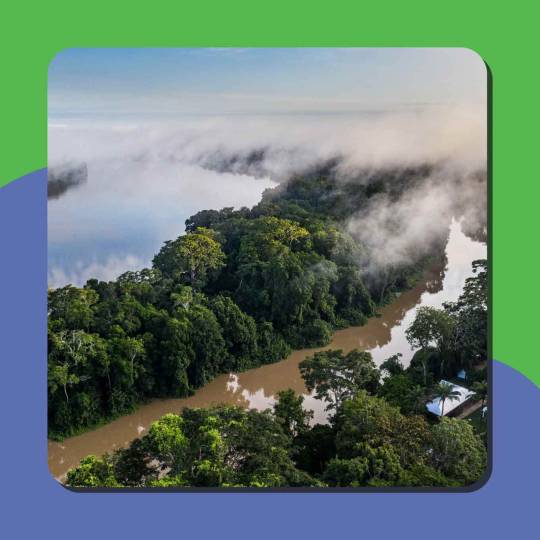
Pictured: Nouabalé-Ndoki National Park. Photo courtesy of Scott Ramsay/Wildlife Conservation Society
Evans credits the ongoing collaboration with this milestone, as the MEF and WCS have helped address escalating threats to wildlife in the region.
This specifically includes investments in the ranger force, which has increased training and self-defense capabilities, making the force more effective in upholding the law — and the rights of humans and animals.
“Thanks to the strengthening of our anti-poaching teams and new communication technologies, we have been able to reduce poaching considerably,” Max Mviri, a park warden for the Congolese government, said in a video for the Park’s anniversary.
“Today, we have more than 90 eco-guards, all of whom have received extensive training and undergo refresher courses,” Mviri continued. “What makes a difference is that 90% of our eco-guards come from villages close to the Park. This gives them extra motivation, as they are protecting their forest.”
As other threats such as logging and road infrastructure development impact the area’s wildlife, the Park’s partnerships with local communities and Indigenous populations in the neighboring villages of Bomassa and Makao are increasingly vital.
“We’ve seen great changes, great progress. We’ve seen the abundance of elephants, large mammals in the village,” Gabriel Mobolambi, chief of Bomassa village, said in the same video. “And also on our side, we benefit from conservation.”
Coinciding with the Park’s anniversary is the roll-out of a tourism-focused website, aiming to generate 15% of its revenue from visitors, which contributes significantly to the local economy...
Nouabalé-Ndoki also recently became the world’s first certified Gorilla Friendly National Park, ensuring best practices are in place for all gorilla-related operations, from tourism to research.
But gorillas and elephants — of which there are over 2,000 and 3,000, respectively — aren’t the only species visitors can admire in the 4,334-square-kilometer protected area.
The Park is also home to large populations of mammals such as chimpanzees and bongos, as well as a diverse range of reptiles, birds, and insects. For the flora fans, Nouabalé-Ndoki also boasts a century-old mahogany tree, and a massive forest of large-diameter trees.
Beyond the beauty of the Park, these tourism opportunities pave the way for major developments for local communities.
“The Park has created long-term jobs, which are rare in the region, and has brought substantial benefits to neighboring communities. Tourism is also emerging as a promising avenue for economic growth,” Mobolambi, the chief of Bomassa village, said in a press release.
The Park and its partners also work to provide education, health centers, agricultural opportunities, and access to clean water, as well, helping to create a safe environment for the people who share the land with these protected animals.
In fact, the Makao and Bomassa health centers receive up to 250 patients a month, and Nouabalé-Ndoki provides continuous access to primary education for nearly 300 students in neighboring villages.
It is this intersectional approach that maintains a mutual respect between humans and wildlife and encourages the investment in conservation programs, which lead to successes like 2023’s poaching-free milestone...
Evans, of the Park’s management, added in the anniversary video: “Thanks to the trust that has been built up between all those involved in conservation, we know that Nouabalé-Ndoki will remain a crucial refuge for wildlife for the generations to come.”"
-via Good Good Good, February 15, 2024
#conservation#congo#republic of congo#elephant#gorilla#endangered species#biodiversity#conservation news#conservation efforts#indigenous communities#national park#protected areas#poaching#elephant poaching#ecology#biology#environment#environmental news#forests
1K notes
·
View notes
Text
Here, have a spark of hope.
The reality is that no single person can fix the entirety of the current ecological imbalance that has been literally centuries in the making at this point. Yet there are so, so many of us who care, and who are doing what we can to make a difference in whatever every day to day ways we're able. I often think of conservation efforts like the Loren Eiseley story "The Star Thrower" (aka, "the starfish story"). Amid a beach full of stranded starfish, one person cannot possibly save them all, but they can spend what time they have saving those they're able.
And this study shows that these efforts do, in fact, make a difference, not just for starfish but a myriad of species. This meta-analysis of almost 200 studies definitively proves that conservation preserves and restores biodiversity, keeping more species from going extinct. It's all too easy to get entangled in the losses, but we even more need to allow ourselves to celebrate the wins.
That success is crucial to convincing governmental entities and other stakeholders that putting funds toward conservation efforts makes a significant difference and is not only worth the investment, but worth increasing. And, on a personal level, it's necessary for those of us who care so deeply for this world to know when our efforts are having an impact, to buoy us up when the anxiety and grief over ecological destruction wears us down.
There is hope. Keep it up, folks; it's helping <3
#conservation#environment#environmentalism#extinction#endangered species#animals#wildlife#biodiversity#nature#science#scicomm#hope#solarpunk#hopepunk#hopecore#hopeposting#optimism#ecology#habitat restoration#restoration ecology
623 notes
·
View notes
Text
Wet Beast Wednesday: bone-eating worm
Happy (almost) Halloween from us at Wet Beast Wednesday. What better to celebrate the spooky holiday than with a spooky animal? These critters are so spooky they even scare skeletons. Sometimes called zombie worms or bone worms, bone-eating worms are scavengers that play an important role in deep seas. Try not to get too scared.

(Image: a cluster of bone-eating worms on a bone. Their plumes are visible, looking like red feathery structures emerging from a clump of brown sludge. End ID)
Bone-eating worms are members of the genus Osedax, with 26 species currently known. My favorite is Osedax mucofloris, which means "bone-eating snot flower". They are small tube worms, reaching between 2.5 and 7 cm (1 to 2.7 in) in length. The body is divided into three segments, the trunk, ovisac, and root. The trunk makes up the majority of the body and it topped by red plumes that act as gills. At the base of the trunk is the ovisac, where eggs are produced. Below that are the roots that bore through the bones the worms live on. This is done by secreting carbonic acid that is produced through anaerobic respiration. The roots also produce a mucus sheath whose purpose is not fully known. It may protect the body from the acid or may prevent the acid from dissolving the hole the worm lives in. As with other tubeworms, the worm generated a protective sheathe to live in. Normally, the plumes extend out of the sheathe to respirate, but when threatened, they will withdraw into the tube.
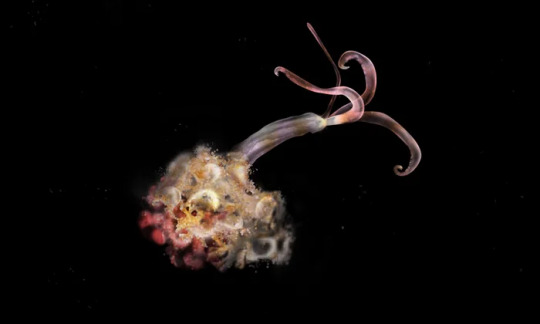
(Image: a bone worm removed from the bone. It is a long, translucent tube with reddish plumes on one and a lump of wavy roots on the other. End ID)
Bone-eating worms lack a mouth, anus, and digestive system. To obtain nutrients, they exist in a symbiotic relationship with bacteria. As the worms break down the bone, they release lipids and proteins that the bacteria consume to produce energy in the form of glycogen, which is transferred to the worm. The worm then uses the glycogen to power itself and feeds it to the bacteria to keep them alive. The worms also use collagen, which is the primary component of bone. Many of the symbiotic bacteria species need the collagen, which the worm provides by breaking down the bone. Curiously, many of the symbionts produce toxins that disrupt the membranes at the roots, leading to infection. The bacteria are also found surviving outside of symbiosis with the worms Because of this, it is debatable whether the relationship between the worm and its bacteria is mutualistic (both parties benefit) or commensal (one party benefits, the other neither benefits nor suffers).
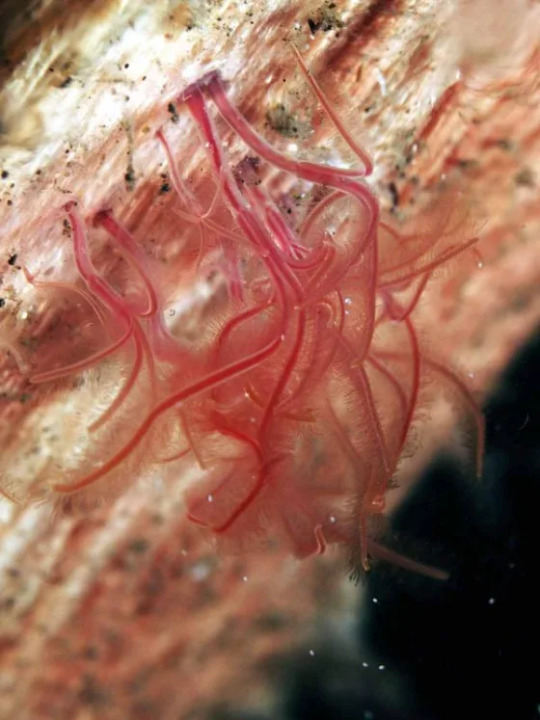
(Image: a cleared view of bone worm plumes emerging from a bone. End ID)
Bone-eating worms are found worldwide in oceanic depths ranging from 10 to 4,200 meters (30 to 14,000 ft). They are most commonly found on the skeletons of whales, but will also colonize fish bones and even, in one experiment, cow bones. Whale bones seem to be preferred both because of their large size and the large quantity of lipids found within. Whale skeletons can often be seen covered with bone worms, giving them the appearance of red shag carpeting. As the worms break down bones, other animals can take better advantage of the nutrients within. The presence of bone worms at a whale fall has been shown to increase the biodiversity of the site. Bone-eating worms are ecosystem engineers, organisms that significantly alter their habitat. They have been doing this since before whales existed. Fossil sea turtle and plesiosaur bones have been found with signs of bone worm colonization.

(Image: a lone bone worm with its tube visible. Its plumes are whitish. End ID)
The bone-eating worms have one of the most dramatic cases of sexual dimorphism in the animal kingdom. All the worms you see when you look at a whale skeleton are females. The males are 20,000 times smaller and fully microscopic. They still resemble larvae, making them a case of neoteny, an adaptation where juvenile characteristics are retained into adulthood. Harems of males live inside the females' tubes and feed on the nutrients released by the bacteria. As the female generates eggs, the males fertilize them. The eggs hatch inside the female's tube and stay for a while to mature before being released into the water. The fact that the worms are so widely distributed indicated that the larvae can travel vast distances to find a new set of bones, but the means they use to do so is unclear. The extreme sexual dimorphism reduces competition between males and females and ensures the males will always have an available mate to pass on their genes. The species Osedax pirapus do not follow this form of dimorphism. Males are still smaller than females, but they actually look like worms and share the same lifestyle. This increases competition between males and females, but ensures that males can make far more sperm due to their greater size.
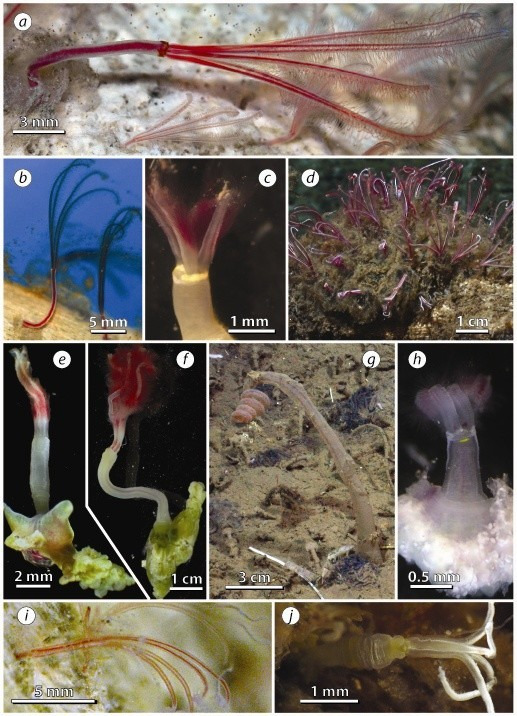
(Image: a collection of images of multiple species of bone-eating worms. Source. End ID)
#BONES FOR THE BONE WORM#wet beast wednesday#bone eating worm#bone worm#zombie worm#osedax#worm#tube worm#polychaete#wormblr#halloween#whale fall#invertebrates#invertiblr#marine biology#marine life#biology#ecology#zoology#animal facts#informative#educational#image described
219 notes
·
View notes
Text
Happy Coelacanth Saturday to those who celebrate! Ran into this beauty at the Naturalis Biodiversity Center in The Netherlands yesterday 😍
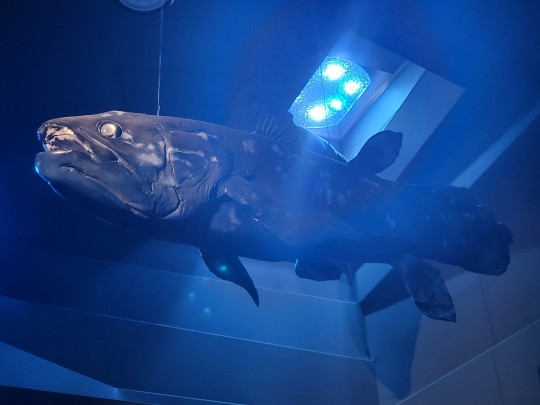
Such a nice surprise 🥰
2K notes
·
View notes
Text
Good News - May 22-28
Like these weekly compilations? Support me on Ko-fi or $Kaybarr1735! Also, if you tip me on Ko-fi or CashApp (and give me some way to contact you if it doesn’t automatically), at the end of the month I'll send you a link to all of the articles I found but didn't use each week - almost double the content!
1. Scientists Invent Healthier More Sustainable Chocolate
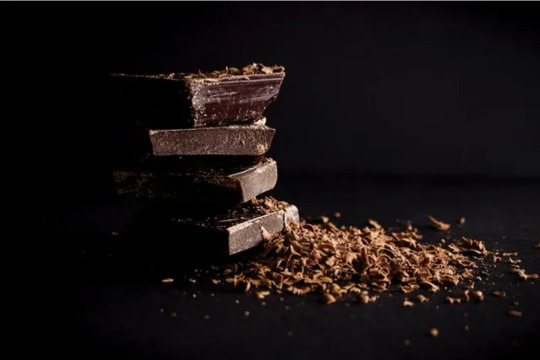
“The new chocolate recipe from researchers at ETH Zurich uses more materials from the cocoa pod that are usually discarded, including more of the pulp as well as the inner lining of the husk, known as the endocarp. […] The resulting chocolate also [was “deliciously sweet” and] had 20% more fibre and 30 percent less saturated fat than average European dark chocolate[, and] it could enable cocoa farmers [to] earn more from their crops.”
2. Vermont Is Coming for Big Oil, Making It Pay for Decades of Climate Pollution

“Legislators in Montpelier are on the brink of enacting the "Climate Superfund Act," modeled after the federal Superfund law, that seeks to make oil, gas and coal companies pay for damages linked to historical greenhouse gas emissions. […] Companies would be held liable for the costs associated with […] floods and heat waves, along with losses to biodiversity, safety, economic development and anything else the treasurer deems reasonable[, that were caused by their emissions].”
3. Important bird habitat now protected in the Rocky Mountain Trench
“Grassland-reliant species in the Rocky Mountain Trench now have more protected habitat thanks to a new [270-hectare] conservation area near Cranbrook. […] About one-third of the Skookumchuck Prairie Conservation Area is forested[…,] Most of the site is a dry grassland[…, and] Three hectares of wetlands add to the landscape diversity and offer crucial benefits to wildlife and water systems in the area. This conservation gem also provides habitat for endangered American badger and excellent winter range for elk, mule deer and white-tailed deer.”
4. Lemur Week marked by 70th breeding success
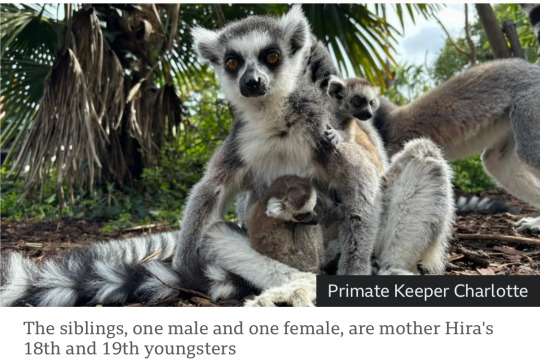
“A wildlife park has celebrated its 70th lemur breeding success ahead of a week raising money to help save the endangered primates. […] The park's open-air Madagascar exhibit is home to 31 free-roaming lemurs and was officially opened in 2008. […] Females are only sexually receptive for just one or two days a year, leaving a small window of opportunity for males to father offspring. […] The two playful siblings, one female and one male, were born to father Bernard and mother Hira.”
5. Innovative material for sustainable building
“Researchers introduce a polymer-based material with unique properties. This material allows sunlight to enter, maintains a more comfortable indoor climate without additional energy, and cleans itself like a lotus leaf. The new development could replace glass components in walls and roofs in the future.”
6. Isle of Wight eagles don't pose threat to lambs as feared

“While there had previously been fears that the eagles would feed on livestock, such as lambs, the project has found no evidence of this. [… “W]hite-tailed eagles effectively steal meals from other predatory birds[, which is] a really important ecological role that had been lost within the landscape and is being restored.” [… The birds’] population was boosted by a chick last year – the first time the species has bred in England in 240 years.”
7. Breakthrough discovery uses engineered surfaces to shed heat
“Cheng's team has found a way to lower the starting point of the [Leidenfrost] effect by producing a surface covered with micropillars. […] The discovery has great potential in heat transfer applications such as the cooling of industrial machines and surface fouling cleaning for heat exchangers. It also could help prevent damage and even disaster to nuclear machinery.”
8. New malaria vaccine delivered for the first time

“A total of 43,000 doses arrived by air today from UNICEF, and another 120,000 are scheduled to show up in the coming days. […] They're the first vaccines designed to work against a human parasite. […] Across four African countries, these trials showed a 75% reduction in malaria cases in the year following vaccination of young children. […] The Serum Institute of India, who will be manufacturing the new vaccine, says a hundred million doses will likely be available to countries by the middle of next year.”
9. Urban gardening may improve human health: Microbial exposure boosts immune system
“"One month of urban indoor gardening boosted the diversity of bacteria on the skin of the subjects and was associated with higher levels of anti-inflammatory cytokines in the blood. The group studied used a growing medium with high microbial diversity emulating the forest soil," [… whereas] the control group used a microbially poor peat-based medium. [… N]o changes in the blood or the skin microbiota were seen. […] “This is the first time we can demonstrate that meaningful and natural human activity can increase the diversity of the microbiota of healthy adults and, at the same time, contribute to the regulation of the immune system."”
10. Cities Are Switching to Electric Vehicles Faster Than Individuals

“[M]ost large cities have adopted some kind of climate goal, and some of them are buying EVs for their municipal fleets at a faster rate than the general public. And that progress could speed up as more EVs enter the market and as cities get educated about grant funding and tax incentives that were passed over the last four years.”
May 15-21 news here | (all credit for images and written material can be found at the source linked; I don’t claim credit for anything but curating.)
#hopepunk#good news#chocolate#sustainability#farming#health#vermont#big oil#oil companies#climate change#cooling#technology#nuclear#malaria#vaccine#africa#unicef#eagles#livestock#england#birds#electric vehicles#glass#energy efficiency#habitat#conservation#lemur#zoo#gardening#urban gardening
344 notes
·
View notes
Text
Greek Gods 101: Persephone
Persephone is a goddess of the underworld, spring growth, agriculture, renewal, death and rebirth, and the cycle of life. Excluding the universal offerings, some common offerings include:
Flowers
Bones
Pomegranate and Pomegranate Products
Depictions or Imagery of Butterflies
Seeds
Tea
Dirt from a Dead Plant (or Person)
Wine
Depictions or Imagery of Pigs
For devotional acts, some activities that can be done for her include:
Gardening
Taking Care of Graveyards
Visiting Forests and Fields
Learn About Local Plants, Flowers, and Herbs
Going Bone Hunting
Creating Flower Crowns
Creating a more Biodiverse Lawn/Backyard
Not Killing Animals (Spiders, Mice, Etc.)
She is celebrated in multiple Athenian holidays:
Lesser Mysteries
Eleusinian Mysteries
Proerosia
Stenia
Thesmophoria
Heliogenna
#Persephone#persephone deity#persephone goddess#deities#hellenism#helpol#hellenic#hellenic pagan#hellenic polytheism#hellenic polytheist#hellenic community#hellenic deities
419 notes
·
View notes
Text
The Nature-Inspired Journey of Emperor Hirohito
Walking in the Footsteps of Hirohito: A Greenery Day Exploration The story of Greenery Day which has a name change to “Showa Day” takes us back to the youthful days of Japanese Emperor Hirohito, a man whose passion for marine biology and nature shaped the celebration we honor on April 29. Showa Day is the revamped name for Greenery Day, honoring Emperor Showa’s fondness for plants, also known as…

View On WordPress
#April 29#biodiversity documentation#Biodiversity Inventory#Celebrating Life and Science#Citizen Science#City Nature Challenge#Cnidarians#Communing with Nature#Discovery and Understanding#Emperor Hirohito#Environmental Legacy#Evolution of Tradition#George Genereux Urban REgional Park#Global Appreciation#Global Health#Greenery Day#Greenery Day Chronicles#Humblest Orders of Life#Hydrozoans#iNaturalist#iNaturalist app#inspiration#interconnectedness#invasive species tracking#Japanese Culture#Japanese Emperor#legacy#Marine Biology#Marine Life#Microscopic Observation
2 notes
·
View notes
Text
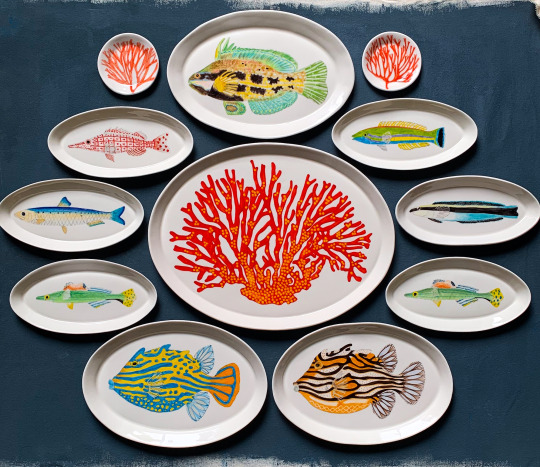
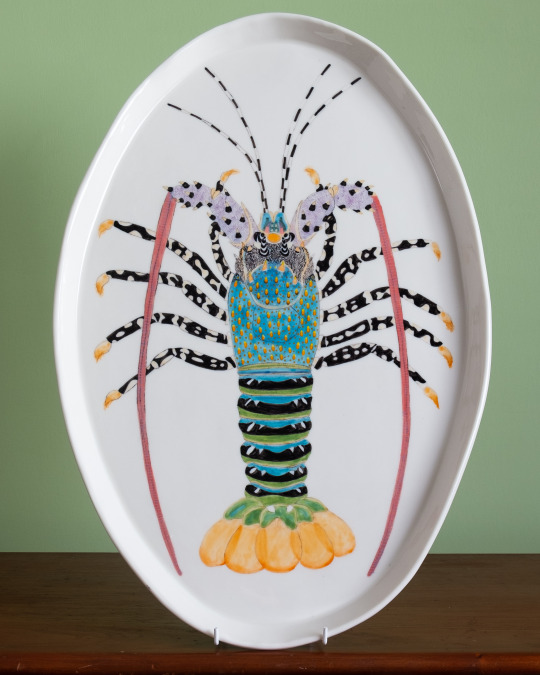

In a Celebration of Biodiversity, Vibrant Marine Creatures Swim Across Casa Adams’ Porcelain Platters
787 notes
·
View notes
Text
I want to talk about the latest Doctor Who episode looking at monoculture and worldbuilding and how it adds fantastically to the whole episode.
I knew about the twist in the episode before I went into it, so I have less to say about how the racism shocked me and more about the society they function in.
As I mentioned in a previous post, none of them experience the world around them- pretty much at all.
I watched Lindy walk to work and I thought to myself "is that their gardens? They never stop to look at them?" Maicured grass with decorative shrubs- not only is the grass itself a symbol or capitalism and class systems, but it's perfectly kept and that's pretty much all the biodiversity you see.
It's a monoculture, it's not hospitable to insects, and it reveals more about the planet to you. It's not hospitable to insects because they aren't meant to live there. There probably even aren't any, thanks to the forcefields around the city. They may be seen as pests, but they're absolutely vital to an ecosystem. It makes me imagine that even the dirt housing the grass is likely free of microfauna- meaning some other technological intervention is taking place to make the grass stay green- it might not even be real. Which implies nothing can grow.
Also note you also don't see any pets.
Additionally, the doctor that pops up on Lindy's screen notes she doesn't need to urinate. Sure it's just a silly joke about how when she gets scared she suddenly does need to. But it tells you:
1) That is seen as a good thing, having to pee is seen as an inconvenience or maybe a social faux pas
2) If she doesn't need to pee, she doesn't need to drink. If she doesn't need to drink, she doesn't need to eat either
And if she doesn't need to eat, she probably doesn't, and she almost definitely never cooks either. I'll say it a million times- as will Dungeon Meshi as it's surged in popularity: you need to eat to be alive and, in fact, being alive is all about being able to eat- finding balance and enjoyment and sharing experiences and staying alive. It's a celebration of who you are and where you came from and how good it is to still be alive. And in their society- it's just gone.
Everyone dresses so similarly and even acts similarly. Everyone dresses in clean cut clothing and pastels- even those who have more eccentric styling or hair, they fit into this world and it's not commented on. The most diversity they have is Goth Paul and even he doesn't dress fully in black- he has an almost pastel purple in his hair. So even with those "different" they're actually quite similar
(Thinking about it. Did anyone in that episode have curly hair besides the Doctor...?)
And it all leads back to monoculture. Even think about how everyone in the city is the same sort of demographic: 17-27, rich, white. Likely also able bodied and neurotypical. Nothing can live or thrive in a monoculture, no one can or will change, and so they stagnate- as does the world around them.
People become more accepting and open and kind when they try new experiences and meet new people, by expanding their worlds, they become more tolerant- but this is a world in which that can never happen. Even Ricky September, who turns off his bubble, stays inside to read. He never goes out, never tries anything- so not even he would have the capacity to change, truly.
Knowledge is such a powerful tool as well as being open to outside influences and change. By living with people who are the same, they can never take on the wisdom of their elders, and by living in a monoculture, their fashion will never change, they will never try new food, they will never appreciate new growth on plants or learn to take care of pets.
They can never change or grow. And the racism building their society has ensured that. They will never learn empathy, because they will never interact with different races and are taught to be disgusted by them. They will never be able to experience the joys of those cultures either, not that they deserve them, they won't pick up new fashion or recipes or dance or music. And from their point of view, they never want to.
Experiencing the world will teach you much more than books ever could. Ricky September showed bravery and empathy from his limited freedom, much more than Lindy was capable of. But he would still be racist if it came down to it, because why would he be otherwise?
This is their perfect society: nothing can live there and nothing ever will. And thanks to it, not one of them will survive.
#long post#worldbuilding#doctor who spoilers#15th doctor#dw spoilers#doctor who#dot and bubble#lindy pepper bean#ricky september#ncuti gatwa
192 notes
·
View notes
Text
Spock's World Inspired Holiday Card circa 1992
December 1992. Spock's World was among my favorite novels. I had just turned 19 years old that month. In keeping with the tradition of making holiday cards, that year I drew artwork inspired by a scene in Spock's World, the Star Trek novel by Diane Duane.
No computer. No printer. This was 1992. I drew it in pencil and darkened it with ink. The message was all hand lettered. My dad made copies of the artwork at his office. Each copy was colored by hand with colored pencils and crayons.
The image centers on the IDIC symbol, Infinite Diversity in Infinite Combination, a concept central to Vulcan philosophy. Diane Duane wrote the most beautiful passage in Spock's World that simply explained the meaning of IDIC. I copied the passage for the message inside the card. The IDIC symbol was surrounded by animals, plants, and other organisms representing the biodiversity of Earth.
The passage from Spock's World was from a scene where Surak was in the desert and saw the giant sandworm-like creature, referred to as the Underlier (called A'kweth or Tcha'besheh). Both beings paused and beheld one another, the Underlier and the Vulcan, in the vast desert under the light of T'Khut (called The Watcher), Vulcan's sister planet.
"How delightful to be so different from something. No need to understand them, particularly; that might come with time and would be an added delight. But it was enough to accept their difference, to celebrate just that without anything added. Creation, in itself, was joy, the difference was joy, the celebration of it was joy."
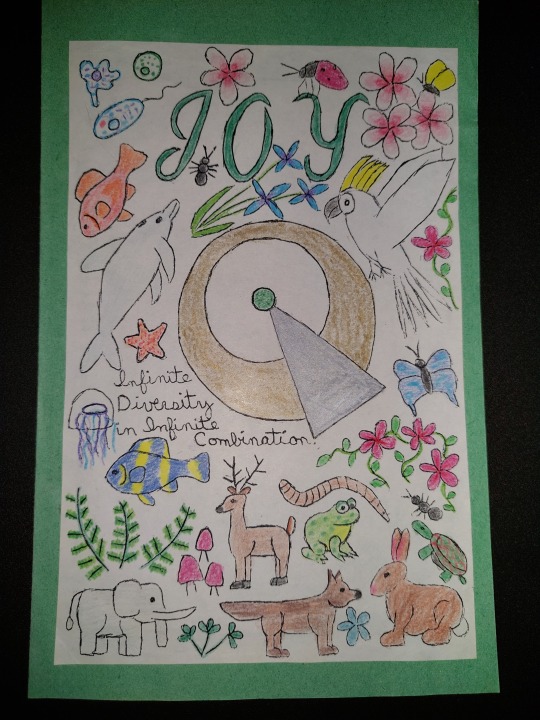
Front of card. Star Trek inspired greeting card artwork. Based on the novel Spock's World. Image features the Vulcan IDIC symbol and cartoon drawings of animals representing diversity. Created in 1992.
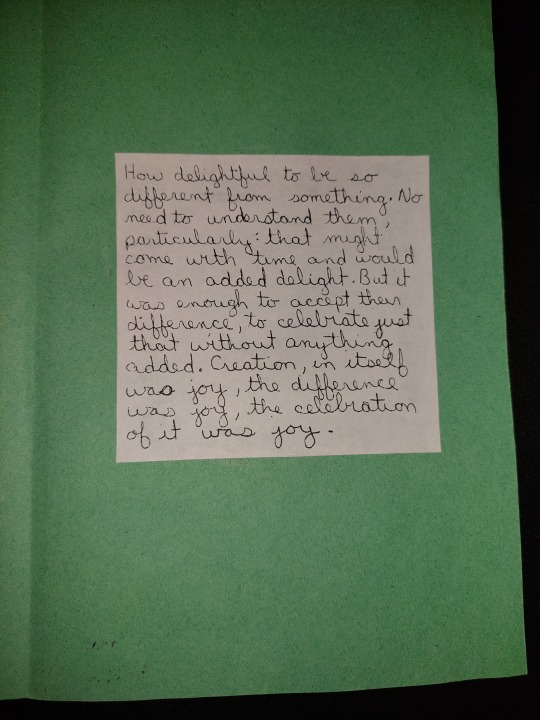
Inside of card. Star Trek inspired greeting card artwork. Based on the novel Spock's World. Image features a quotation from the novel representing diversity and the IDIC philosophy. Created in 1992.

Front and back of card. Star Trek inspired greeting card artwork. Based on the novel Spock's World. Image features the Vulcan IDIC symbol and cartoon drawings of animals representing diversity. Created in 1992. (Copyright Myers Cards 1992.)
The passage in the novel continued:
"There was nothing that could stand against that joy: sooner or later it would triumph. All evil, all death, was a tiny, fretting, posturing thing that knew its own defeat was coming, and it might rage and destroy as it liked. It was doomed. Celebration would win, was winning, had won now. Everything was one moment, and the moment was nothing but triumph and joy."
This resonated with my 18/19 year old self. This still resonates with me today. Oh, my heart! I cry for joy! Such beautiful ideas and words to live by!
Regretfully, I didn't credit the author on the card at the time. I assumed friends and family wouldn't care. It was yet another weird, cheap, homemade holiday card from their weirdo sister / niece / daughter / student / friend.
I hope you enjoy the amateur artwork and Diane Duane's message. Enjoy the diversity and differences. Embrace and embody IDIC.
Thank you, @dduane.
Peace and long life,
Amy
380 notes
·
View notes